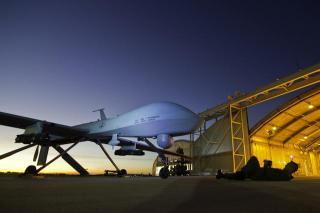
The United Nations Arms Trade Treaty, opened for signature this year, establishes a potentially transformative new global norm. For the first time, it puts in place international prohibitions on the sale and transfer of conventional weapons to armed groups that abuse human rights and humanitarian law, engage in organized crime or commit acts of terrorism and piracy. The Arms Trade Treaty has the potential to save lives.
By Dr. Matthew Bolton and Wim Zwijnenburg*
But the Arms Trade Treaty will only be as watertight as states’ implementation of it, especially as digital and robotics technology transforms the arms industry. New weapons such as miniature drones, modular military robots and unmanned underwater vehicles could pose challenges to this new norm if states or manufacturers attempt to claim the existence of loopholes in the treaty text.
The ATT covers a wide range of weapons from attack helicopters through to bullets, but there are still gaps. The ‘Scope’ of arms covered is in Article 2, and states the treaty “shall apply to all conventional arms within the following categories:
(a) Battle tanks;
(b) Armored combat vehicles;
(c) Large-calibre artillery systems;
(d) Combat aircraft;
(e) Attack helicopters;
(f) Warships;
(g) Missiles and missile launchers; and
(h) Small arms and light weapons.”
Except for the addition of small arms and light weapons, this list is derived from the categories covered by the UN Register of Conventional Arms, a voluntary international arms trade reporting system. The Register’s website states that “Not all arms are covered” by this list, just those considered offensive rather than defensive.
During the final negotiation conference in March this year, we wrote and distributed a paper called “Futureproofing the Draft Arms Trade Treaty.” Our policy brief raised concerns that certain new weapons – such as armed unmanned ground vehicles that were smaller than the Register’s definition of tanks or armored combat vehicles – might create grey areas that could be exploited by states or manufacturers acting in bad faith.
With an increasing global market for unmanned technology, distinctions between civilian and military applications are easily blurred. Some new robotic systems can be sold separately from the guns that attach to them and thus might not fall into the definition of a weapon, despite their deadly potential, allowing potential circumvention. Future conflicts will likely see in increase of these types of weapon systems, providing both states and non-state actors, with new capabilities to use lethal force. These capabilities stretch the boundaries of international humanitarian law and redefine the interpretations of what constitutes a battlefield (see Matthew’s lecture on this, here).
The final treaty text created some possibilities for tightening the Arms Trade Treaty in the future. However, amending the treaty at this time may be both politically infeasible and possibly undesirable while the treaty is being established as a universalized international norm. Moreover, the Arms Trade Treaty has not yet entered into force and so for now the text remains as it is.
But in the meantime this does not let civil society and concerned states off the hook. Ultimately, the strength of the Arms Trade Treaty will derive not from the literal meanings of its text, but from how it is put into practice, which we have the capacity to shape. As expressed by Norway in the UN General Assembly First Committee on 14 October, “The Arms Trade Treaty should, when it enters into force, be a dynamic and living instrument, open for improvements and changes in the future.”
On July 15, a report written by a UN General Assembly-mandated Group of Governmental Experts and endorsed by Secretary-General Ban Ki-moon, recommended that “Member States report armed unmanned aerial vehicles” – i.e. weaponized drones – to the UN Register of Conventional Arms under that categories of “combat aircraft” and “attack helicopters.”
The Group’s report – written by officials of 15 diverse countries, including the all major arms exporters (the USA, Russia, China, UK, France and Germany) – represents the most authoritative statement on the categories that the Arms Trade Treaty borrows. This means armed drones will be considered covered by the treaty’s Scope. Clearly, many states consider improved transparency over arms exports and new technologies of vital importance for providing oversight, checks and balances in the global arms market.
In consulting with diplomats negotiating the treaty, many assured us that their governments would interpret the spirit of the Scope broadly in evaluating transfers (and the behavior of other states). But this means it is up to us in the Control Arms coalition to hold states to that broad interpretation and build on the work of the Group of Governmental Experts’ report. We can do this by monitoring which weapons states put on their Arms Trade Treaty National Control Lists (See Article 5, para. 2) and calling out what they fail to include.
The Control Arms coalition members have succeeded in persuading states to negotiate a strong Arms Trade Treaty, but our job now is to win the more complex discursive struggle – that of interpretation and implementation. The Arms Trade Treaty must be a living document, able to adapt to the challenges of new technologies.
For further details on how this can be done, read our new policy paper “Futureproofing Is Never Complete: Ensuring the Arms Trade Treaty Keeps Pace with New Weapons Technology.”
* Dr. Matthew Bolton is Assistant Professor of Political Science at Pace University in New York City. He is an expert on the politics of conventional weapons and author of Foreign Aid and Landmine Clearance (I.B. Tauris). Follow him @politicalmines.
Wim Zwijnenburg is Policy Advisor for IKV Pax Christi’s Security & Disarmament team. He works on the impact and proliferation of armed drones, the Toxic Remnants of War project with a focus on Iraq, and the Arms Trade Treaty. Follow him @wammezz.
You can also read this blog on the Control Arms Blog.



